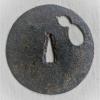Dear NMB members, may I use this fascinating thread to present myself as new on board? I am greeting all members! Still learning, I am in contact with Japaneses arms since nearly forty years. As an active knife and traditional tool smith I have some experience with steel. A few years ago I began to research about TEKKOTSU, discussing the theories with other TSUBA collectors. Some were in opposition to my own knowledge and practice with the properties and the 'behavior' of steel. I have been reading quite a while here in the forums and as the discussion in this thread turned to TEKKOTSU I thought it might be helpful to add my personal observations and ideas to this subject. To start with, I want to say that I fully agree with what Ford Hallam said about it. As long as no scientifical examination has been made, one has to accept what is known about steel, and belief or even conviction are not helpful. Let me start with the article from Andy M. where I found this contradiction (among others which have already been cited). I cite:.....Tekkotsu may be defined as segregated areas of high carbon content, formed as a result of a process of successive episodes of heating, folding and hammering of an iron plate. Generally speaking, increasing the carbon content in iron results in decreased ductility...... The last phrase is correct, but then the less ductile hard steel in a TSUBA would not protrude between layers of softer iron as to form TEKKOTSU. Working on the anvil, steel and iron can be well differentiated even at higher forging temperatures. Steel would not be 'squeezed' out between layers of iron. Imagine a steak instead of a hamburger in a BigMac..... Most of the members here have probably seen TSUBA with sword cuts on them. These are fine, sharp edged grooves. Try to do that with a hardened TSUBA! On the other hand I have yet to see TSUBA with chips that could lead to the conclusion that a blade hit a hardened metal obstacle. The description of 'dense, hard steel' is misleading. You cannot densify steel by hammering or any other technique, the density is always 7,85 (roughly). Of course you can hammer down a piece of TAMAHAGANE and densify it's structure, eliminating any voids that occurred in the process of production. But there is no such thing as 'dense iron'. The surface of a TSUBA may well give an impression of more or less structure, but this has nothing to do with the metal's physical properties. It was mentioned that acid treatment might eat away some superficial parts of the material and thus leave TEKKOTSU on the surface. I believe that this is correct, and if so, it supports Ford's theory that TEKKOTSU is more likely iron (or low carbon content steel) because the acid works best on high carbon steel. If on the other hand TEKKOTSU was indeed high carbon steel, we would find hollowed out grooves and lines in TSUBA MIMI instead of TEKKOTSU standing out. Relating to the etching processes I may add that all metals used in TSUBA were chemically treated or patinated with the exception of gold. In some places, silver was also left untouched. I do not mean that all TSUBA were treated, but these patinations were not only applied for aesthetic purposes but as well for corrosion protection. As examples, the well known SABIJI on iron or the 'foxes' red' on copper are very durable coatings, and not all recipes are yet known, as far as I know. In an attempt to prove my ideas to myself I made some samples with different layers of iron and steel. After forge welding them I ground them smooth at the sides and hammered them down at usual forging temperatures. The results were as expected: it was the softer iron that came visibly out at the sides. Going back to the production of steel one hast to remember that rather impure TAMAHAGANE had (and still has) to be processed with repeated folding and welding to become a refined and usable sheet material. It has nothing to do with intended production of layered steel material for improved impact stopping capacities as mentioned in the article. The fact that the production process is sometimes still visible in the workpiece has - at least in my understanding - more likely to do with a typical Japanese attitude found in many artistic and crafts fields such as metalwork, SUMI-E, pottery, and some woodwork. One word to the subject of carbon diffusion. This is influenced greatly by time, temperature and the way to travel , e.g. the thickness of layers. It ist quite well possible to create a decorative Damascus steel from high carbon steel and carbon free iron without having considerable carbon diffusion. This needs as few weldings as possible and thick layers. When it comes to longer periods of forge welding and folding, the overall time of heat application gets longer and the layer diameter diminishes, ending in a balanced carbon content in all layers. An obstacle to carbon diffusion is a layer of pure nickel. To increase research on the forming of TEKKOTSU we could also ask those TSUBASHI who are still able to produce TEKKOTSU, as I heard. But I am afraid there will be no satisfying reply for Westerners, when the artists answers: I use the same material as my ancestors and the techniques my master taught me, and the results are as expected..... Regards, Jean


